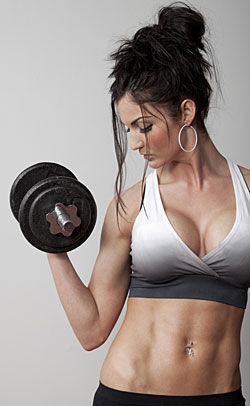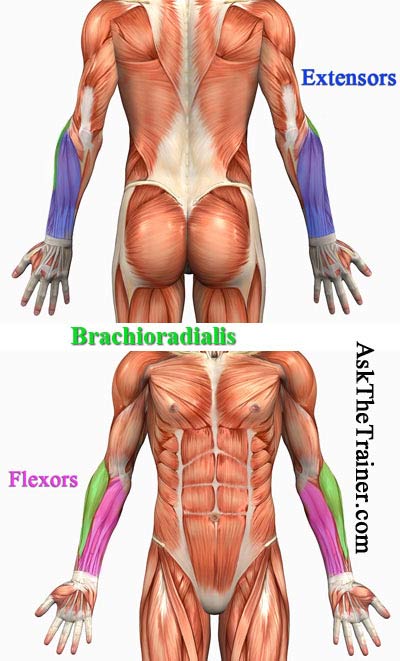- Like
- SHARE
- Digg
- Del
- Tumblr
- VKontakte
- Flattr
- Buffer
- Love This
- Save
- Odnoklassniki
- Meneame
- Blogger
- Amazon
- Yahoo Mail
- Gmail
- AOL
- Newsvine
- HackerNews
- Evernote
- MySpace
- Mail.ru
- Viadeo
- Line
- Comments
- Yummly
- SMS
- Viber
- Telegram
- JOIN
- Skype
- Facebook Messenger
- Kakao
- LiveJournal
- Yammer
- Edgar
- Fintel
- Mix
- Instapaper
- Copy Link
 Complementing Your Arms Workout With Forearm Exercises
Complementing Your Arms Workout With Forearm Exercises
The forearms are actually involved in many more exercises than you might think. Any time you are gripping resistance of any kind in your hands, you are working your forearms. This means that you don’t need to spend a ton of time on your forearms since they get a fair deal of work during most strength training workouts.
However, adding a few key forearm isolation exercises to your weight training routine will improve your wrist stability, making wrist injury less likely. You will also benefit from a stronger grip, increased functional strength of the arms, and of course, sexy, well-defined forearms. To me, this is great news since forearms are one of the most visible body parts on a day-to-day basis!
Forearms exercises are a great complement to a biceps exercise or a triceps exercise workout, ensuring that your forearms and wrists are getting some love as well.
We’ll start by going over the basics of forearm anatomy including the extensors, the flexors, and the brachioradialis. Next, we’ll go over some guidelines to follow while performing the forearm exercises, and then move on to exercise descriptions complete with free videos.
Jump to the Forearm Exercises or continue reading to learn more.
Basic Forearm Anatomy
Understanding forearm anatomy will help the exercises make a lot more sense to you. You’ll also be better able to maximize the best forearm exercises since you will be able to feel which muscles are working and make sure that’s matching up to the ones that are supposed to be working according to the exercise descriptions.
We’ll discuss three of the main actions performed by the forearm muscles: elbow flexion, wrist flexion, and wrist extension. Read on to learn what those terms mean and which muscle is responsible for each action.
Brachioradialis
The brachioradialis is a large forearm muscle which travels down the outside edge of the forearm when you’re standing with palms forward. Since the brachioradialis actually starts on the upper arm above the elbow, it helps the biceps and the brachialis during elbow flexion, which is the action of bringing the forearm toward the upper arm as in a curl. The brachioradialis tendon attaches at the bottom of the radius.
Wrist Flexors
Wrist flexion is the action of bringing your palm toward the inner surface or your wrist. A group of six wrist flexors traveling down the inner surface of the forearm work together to flex your wrist. Some of these six flex the fingers, which is the action of making a fist or gripping a weight. It isn’t necessary to know the names of all the wrist flexors; just remember we’re working with a muscle group here and not just one muscle.
Wrist Extensors
Wrist extension is the opposite of wrist flexion. During wrist extension, you’re bringing the back of your hand toward the back of your forearm. Eight extensor muscles work together to extend your wrist. Like the flexors, some are also involved in finger extension, in which you attempt to pull your fingers back.
Note that you don’t actually have to be moving your wrist through the motions of extension and flexion to work the extensor or flexor muscles. Much of forearm muscle action is isometric, meaning the muscle is actively contracting while staying the same length. These isometric contractions of the forearms are happening when you grip a weight to perform any weight-bearing exercise. That’s why the forearms typically don’t need a ton of work; a few exercises are enough to do the trick.
Exercise Guidelines for the Best Forearm Exercises for Women
The forearms consist of mostly type I muscle fibers, which are high in endurance and slow to fatigue. This means that you generally need to perform high reps with lower weight when you work out your forearms. Aim for sets in the 15-20 repetition range. The exception is during hammer curls, in which you’ll want to use about the same resistance you’d reach for during a regular biceps curl and perform around 12 reps.
The amount of weight to use during the best forearms exercises for women will vary from person to person based on your fitness level. As with any other strength training exercise, you will want to use the amount of weight which will cause your muscles to fatigue within the desired rep range of 12-20. This may take a little trial and error to determine when you’re getting started.
Beginning lifters should start with one set of each of these best forearms exercises to see how the body adapts. If you’re more used to strength training, perform two or more sets according to your own goals. We have many articles on strength training where you can learn all about sets and repetitions, how to structure your sets, and much more.
While performing your forearm exercises, your core and your glutes tight and engaged to stabilize your body. A stabilized core will help you keep the action in the intended muscles while protecting the spine from twisting this way and that.
Best Forearm Exercises for Women
These three forearm exercises are the only forearm isolation exercises you’ll ever need to tone and sculpt your forearms while increasing wrist stability and grip strength. Read the descriptions carefully and watch the videos to get the most out of these excellent forearm exercises.
Hammer Curls
Hammer curls target the brachioradialis, that long, sleek muscle running down the outside of your forearm. Hammer curls have the added benefit of activating the brachialis as well, which is a deep upper arm muscle underlying the biceps powerfully involved in elbow flexion.
You will likely want heavier resistance for your hammer curls than you will want for the reverse curls and wrist curls described below. You can use dumbbells, resistance bands, or a low cable machine to do hammer curls.
To begin a hammer curl, stand with the resistance grasped at your sides with your palms facing in toward your body. Curl the weight up toward the front of your shoulder without rocking or using momentum. Lower the weight slowly and deliberately back down to your side.
You can do one arm at a time, alternate arms, or even do both arms at the same time as long as you are moving in a slow and controlled way without letting your shoulders rise or rocking your body.
Reverse Curls
Reverse curls are a great exercise for working the forearm extensors as well as the brachialis. This exercise can be performed using dumbbells, a low cable machine, resistance bands, or a barbell as demonstrated in the video.
Reverse curls look very similar to the well-known normal curl, but as you may have guessed, your grip is reversed. Grasping the resistance in front of you with palms down, curl your arms up toward the front of your shoulders. Lower the weights slowly, paying as much attention to the lowering phase as the lifting phase. Keep your elbows pinned to your sides at all times. Don’t rock or use momentum at all to get the weights up.
You may find you need to use light weights for this exercise than you may be used to for other exercises such as the hammer curl or other types of curls. That’s fine! This exercise really isolates the forearm muscles, and the forearm muscles aren’t as powerful as the upper arms muscles.
Wrist Curls
This wrist curl set involves both forearm flexors and forearm extensors. Two exercises are performed back to back without resting. You may want to use heavier resistance for the forearm flexion portion (palms up) and lighter resistance for the extension portion (palms down). A couple sets of wrist curls are excellent to totally burn out your forearms as you’re completing an arm workout.
You can do your wrist curls on a low cable machine as shown in the video, or you can use dumbbells, a barbell, or a resistance band tied to a low object such as a couch leg. Wrist curls are a pretty small movement. They’re best performed seated so you can really concentrate on the wrist action.
To perform a wrist curl, start with flexion. Grasp the resistance with palms up and flex your wrists toward the underside of your forearms without moving the forearms or upper arms at all. Straighten your wrists back to a neutral position to complete the rep.
Once you’ve completed a set of wrist flexions, immediately move on to wrist extensions. Switch your grip so you are grasping the resistance with palms facing the floor. Extend your wrists by bringing the back of your hands toward the backs of your forearms, then lower back down to a straight, neutral wrist position.
Both wrist flexion and wrist extension can be performed fairly quickly to get a good pump going. Watch the video to observe an appropriate tempo for wrist curls.
The Bottom Line
Incorporating these exercises into your upper body workout routine is a must if you’re looking for that perfect physique. Aesthetic reasons aside, you’re also going to decrease your chance of wrist injury by improving wrist stability, and you can also expect a stronger grip and improved functional strength in the arms.
What are your favorite arm exercises? Have you tried the exercises covered here? What was your experience? Let us know in the comments below!
About Mae Barraclough
Mae Barraclough, B.S., NASM-CPT, NASM-CES is a certified personal trainer, corrective exercise specialist, and licensed Zumba Instructor. With her passion for health, fitness, and dance, Mae loves learning all she can and sharing her knowledge with others.


